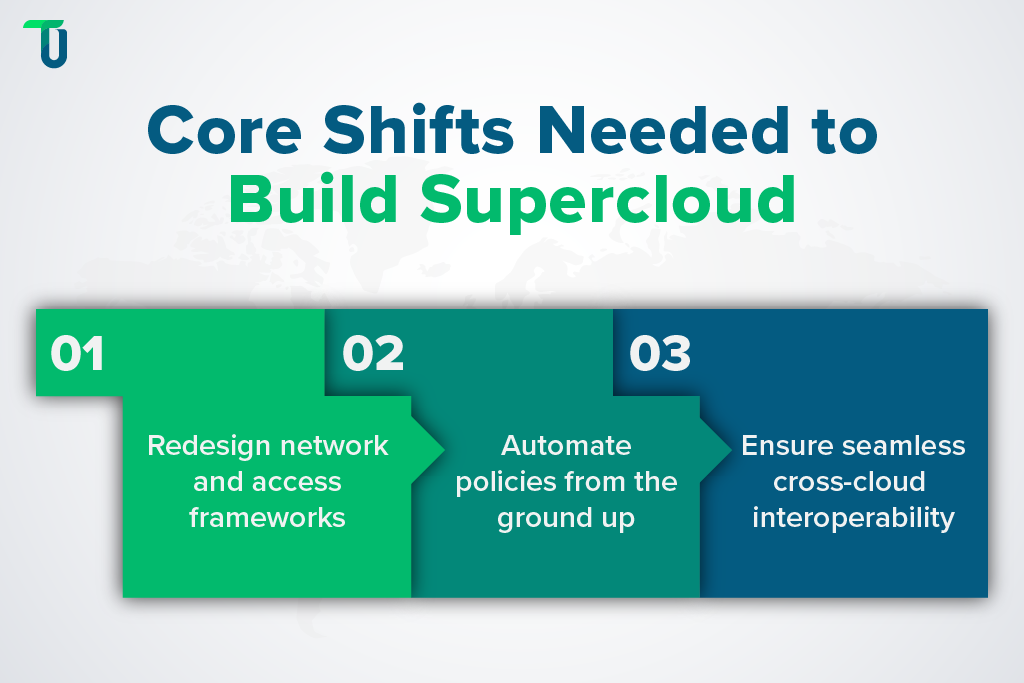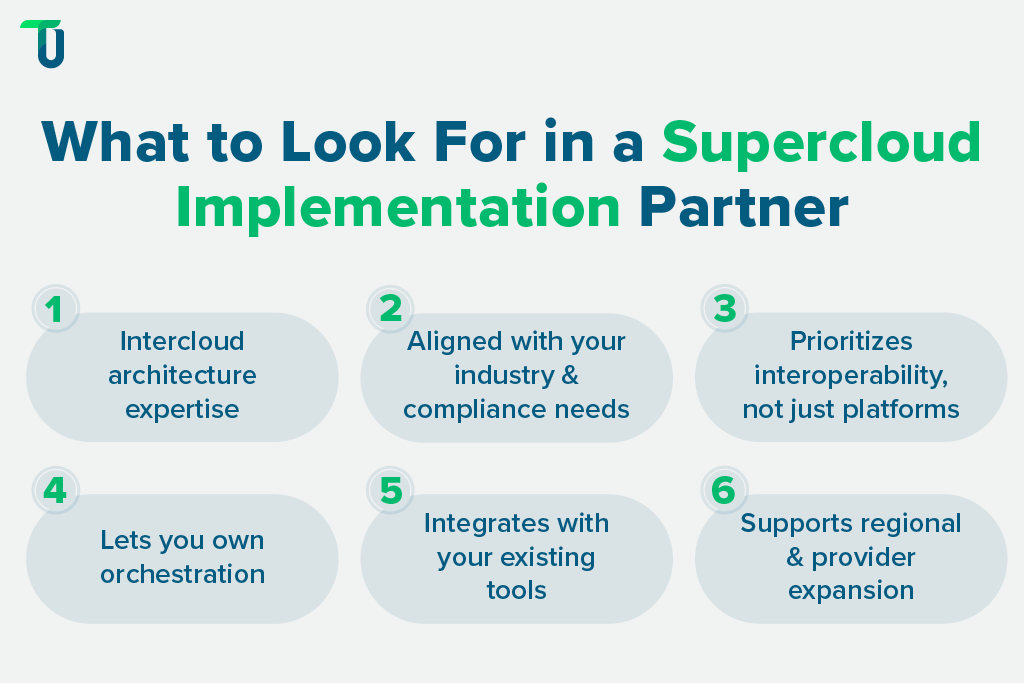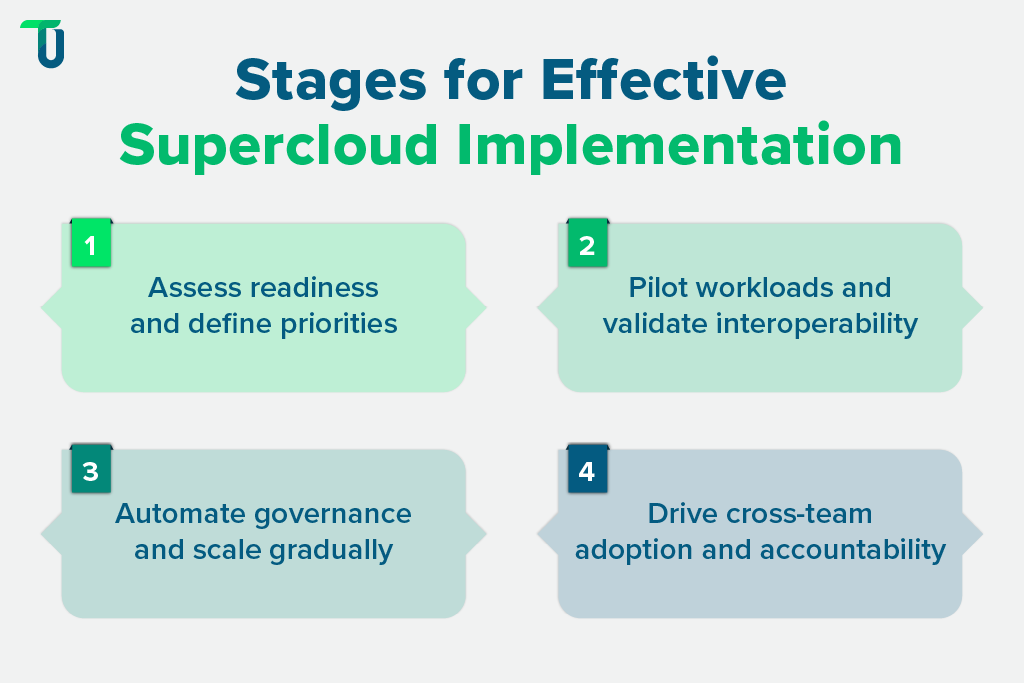What Does Supercloud Implementation Involve?
Supercloud is not just another cloud project. If you're approaching it with a lift-and-shift mindset, it’s time to reassess. This is not about migrating workloads. It’s about building a unified layer that orchestrates, governs, and secures operations across cloud environments — all while maintaining complete control.
And that requires a different playbook.
Unlike traditional hybrid or multi-cloud setups, Supercloud introduces a fundamental shift. You’re not just integrating systems. You’re designing a centralized control architecture that defines how your digital infrastructure scales, operates, and adapts to change.
What that really involves:
- Redesigning network, identity, and access frameworks
- Implementing policy automation from the ground up
- Ensuring seamless interoperability across cloud providers and services

But technology alone won’t get you there.
Supercloud cuts across your entire organization. Infrastructure, security, DevOps, and data governance all must operate in sync. If your teams aren’t aligned on accountability, processes, and tooling, execution will stall.
For CEOs and CTOs, this is a leadership-level decision.
You’re not just overseeing a cloud initiative. You’re enabling enterprise-wide control at scale.
So the real question becomes:
Is your organization prepared to operationalize Supercloud, not just design it? Because success lies in execution, not just architecture.
Defining Your Supercloud Strategy: Questions Every CTO Must Answer
Before you architect anything, you need to align on why Supercloud matters for your business
Because without a clear strategic anchor, even the best architecture will drift.
Supercloud is not just a technology decision. It is a directional one. It defines how you manage control, reduce complexity, and enable innovation across your cloud estate. And the first step to getting it right is asking the right questions — the kind that bring clarity to the leadership table.
Start here:
What are we optimizing for?
Is your north star agility, cost efficiency, compliance, innovation, or a combination? Your answer will influence everything from architecture to tool selection.
How centralized do we want control to be?
Will business units have autonomy, or are you enforcing uniformity from the top? Supercloud supports both federated and centralized approaches, but your governance model must be deliberate. Make a choice based on your organization's maturity level and compliance requirements.
What are our interoperability and sovereignty constraints?
Are you dealing with region-specific data regulations? Vendor lock-in risks? Distributed workloads across providers? These considerations define the flexibility your implementation requires.
This is not just a technical checklist. It is a leadership alignment moment.
Because once you move forward, reversing core decisions becomes costly in both time and credibility.
For CTOs, this is where your architectural foresight sets the tone. For CEOs, this is where business goals must be embedded into the design DNA.
If that alignment does not happen early, Supercloud will remain an idea. Not an enterprise-grade capability.
Turn Supercloud Plans Into Enterprise-Grade Execution
Building Supercloud takes more than architecture; it demands cross-functional clarity and top-down alignment. Get it right with TenUp.
Choosing the Right Supercloud Implementation Services Partner
You can’t build Supercloud alone.
Not because your team isn’t capable, but because speed, expertise, and interoperability demand precision. The wrong partner will cost you more than delayed timelines. It can compromise your architecture, compliance posture, and control.
This is not about hiring a cloud vendor. It is about finding a strategic ally who understands the complexity of your digital estate, not just the platforms you use.
So what should you look for?
- Proven experience with intercloud architecture
- Vertical and regulatory alignment
- Interoperability-first mindset
And before you sign anything, ask the questions most enterprises forget:
- Who owns the orchestration layer — you or the vendor?
- Can their tooling integrate with your current security and observability stack?
- What happens when you expand across new regions or providers?
Once the contract is signed, you are committing not just to services, but also to the terms outlined in the contract. You are committing to foundational decisions that will shape your digital operating model.
CEOs need visibility. CTOs need architectural confidence. The right partner delivers both, or they should not be on the shortlist.

Key Tools and Technologies That Power Supercloud Implementation
The architecture may be strategic. But without the right tools, Supercloud remains a concept.
What brings Supercloud to life—compared to Hybrid and Multi-Cloud models—is the orchestration layer that operates above individual cloud services. It connects, automates, and governs everything across providers such as infrastructure, workloads, policies, and data securely, at scale, and in real time.
Here are the core components every CTO must evaluate:
- Intercloud orchestration platforms
- Unified policy engines and governance frameworks
- Data fabric and integration layers
- Observability and telemetry tooling
Also critical: security observability and threat detection. Modern Supercloud environments embed security insights into every layer, using AI-driven threat analytics to detect cross-cloud anomalies, misconfigurations, and insider threats in real time.
For CEOs, this translates to operational resilience and reduced risk exposure. For CTOs, it means streamlined control, better scalability, and infrastructure that aligns with long-term business goals.
Because when your tools speak the same language, your Supercloud delivers more than just uptime. It delivers intelligence.
Building the Architecture: Supercloud Reference Blueprint
Supercloud is not a one-size-fits-all deployment. But the architecture must follow a few non-negotiables — security by design, interoperability at scale, and governance built into the core.
Here is what a modern Supercloud blueprint should include:
- Network, identity, and access control layers
- Policy and compliance baked into infrastructure
- Modular, API-driven integration points
- Centralized observability and telemetry
A good blueprint is more than a diagram. It is an execution-ready foundation that accelerates adoption, simplifies onboarding, and reduces operational risks.
Supercloud Implementation Roadmap: From Pilot to Enterprise Rollout
You do not implement Supercloud in a single sprint. It is a phased transformation that touches architecture, culture, and control.
Here is what a successful Supercloud rollout should look like:
- Discovery and readiness assessment
- Pilot workloads and testing interoperability
- Governance automation and scaling
- Change management and adoption enablement
Even the best architecture fails without buy-in. Train teams, update processes, and reinforce accountability — just as we did when building a platform that enabled seamless, automated and secure transactions between influencers and brands. Align stakeholders across security, operations, and finance to ensure adoption is enterprise-wide, not just tech-led.
Also, address the human layer. Supercloud demands not just cross-cloud orchestration, but cross-team alignment. That means redefining roles, SLAs, and accountability across DevSecOps, security, and infrastructure to avoid executional silos.

Real-World Supercloud Use Cases: What Adoption Looks Like Today
While Supercloud-aligned architectures may feel like a future-state vision, several industry leaders are already moving in this direction — blending control, interoperability, and scale across cloud ecosystems.
Financial Services: Global Bank Unifies Observability
A global bank leveraged Sumo Logic to centralize logs and telemetry from AWS and Google Cloud. This enabled real-time dashboards, dynamic traffic routing, and regulatory insights across clouds.
Outcome:
- 40% reduction in audit response times
- Unified observability across cloud regions
- Dynamic, policy-driven failover and recovery
Retail: Walmart’s Hybrid Supercloud Architecture
Walmart is building one of the largest enterprise-grade hybrid cloud platforms using Microsoft Azure and on-prem infrastructure. With unified control planes, the company ensures global scalability, resilience, and governance, especially across its supply chain and retail data operations.
Outcome
- Streamlined global supply chain operations
- Unified customer data governance across regions
- Real-time analytics for localized personalization
Banking AI at Scale: Commonwealth Bank of Australia
CBA uses AWS to run 2,000+ AI models daily across 157 billion data points. Their Supercloud architecture enables global governance with region-specific intelligence.
Outcome:
- AI-powered product recommendations in real-time
- Embedded compliance in ML lifecycle
- Infrastructure flexibility without vendor lock-in
Supercloud + AI/ML: What’s Next?
Supercloud is increasingly becoming the foundation for distributed AI/ML infrastructure. Enterprises are leveraging intercloud architectures to train models across regions, deploy inference at the edge, and unify pipelines for observability and compliance.
Your implementation strategy must anticipate these AI-driven demands — not just from a computer standpoint, but also from governance, latency, and portability perspectives.
Forward-looking Supercloud architectures embed AI observability, support hybrid inference engines, and automate model compliance across regions, making them foundational for real-time, intelligent enterprise systems.
Why Choose TenUp Software Services for Your Supercloud Journey
You do not just need a vendor. You need a partner who understands that Supercloud is not about technology alone. It is about business-critical control, operational clarity, and future-ready architecture.
That is where TenUp Software Services comes in.
We specialize in building enterprise-grade cloud ecosystems that scale with confidence, not chaos. From infrastructure strategy to orchestration logic, we work as your extended CTO office, translating complexity into clarity.
Here is what we bring to the table:
- Deep expertise across cloud platforms
- Modular, composable architectures
- Security-first engineering
- Full lifecycle partnership
- Outcome-focused delivery
We do not stop at implementation. We measure success in terms of agility gained, risk reduced, and control returned to your business.
Turn Your Supercloud Strategy Into Execution
Supercloud isn’t just about knowing what to implement. It’s about getting it right from day one. Let Tenup Software show you how.
Frequently asked questions
What’s the difference between Supercloud implementation and traditional multi-cloud setup?
Traditional multi-cloud involves using multiple cloud providers separately, each with its own tools, policies, and operations. Supercloud implementation, on the other hand, builds a unified control layer across clouds—abstracting complexity, enabling seamless interoperability, and centralizing governance, security, and orchestration under one framework.
Why is Supercloud implementation becoming essential for AI and ML workloads?
Supercloud simplifies and scales AI/ML operations by unifying workload orchestration across clouds, enabling real-time inference, dynamic resource allocation, and policy-driven governance, reducing latency, cost, and complexity in distributed model training and deployment.
How can enterprises assess their readiness for Supercloud implementation?
Enterprises can assess Supercloud readiness by evaluating cross-cloud visibility, governance maturity, workload complexity, and their ability to centralize identity, policy, and control. A successful assessment highlights both architectural gaps and organizational readiness across teams, tools, and compliance frameworks.
What key roles and teams should be involved in a Supercloud implementation project?
Supercloud implementation demands cross-functional ownership. Core teams include DevOps, SecOps, Data Governance, Enterprise Architecture, and executive leadership, working together to align strategy, security, and orchestration. Without this collaboration, execution gaps and siloed decisions often derail the project.
Which industries benefit most from early Supercloud implementation?
Industries like finance, healthcare, and retail benefit most, where data sovereignty, compliance, and real-time decision-making are non-negotiable. Supercloud’s centralized control and cross-region flexibility give these sectors a competitive edge in both agility and governance.
What technologies are essential to power Supercloud orchestration?
Supercloud orchestration runs on intercloud orchestration platforms, unified policy engines, observability stacks, and identity federation—all connected by API-first data fabrics and end-to-end security for seamless control across clouds.
How can I choose the right partner for Supercloud implementation services?
Look for a partner (TenUp Software Service LLP) with multi-cloud orchestration expertise, industry-specific compliance knowledge, and a proven track record. Prioritize those offering modular tools, SLA clarity, and shared control over the orchestration layer.

